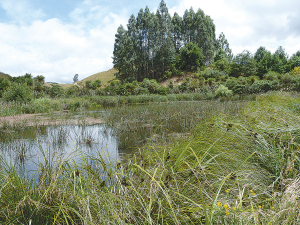Bacteria to prevent fungal diseases
Plant fungal diseases can be devastating for horticulture and agriculture - in the worst cases, wiping out entire crops.
 The team carried out in-depth investigations in the Piako River headwater and Waitapu Stream catchments.
The team carried out in-depth investigations in the Piako River headwater and Waitapu Stream catchments.
A new study shows that analyses how water flows to reach rivers and streams can help reveal what proportion of agricultural contaminants come from past or recent land use practices.
As part of the five-year Critical Pathways programme funded by the Ministry of Business Innovation and Employment (MBIE), Lincoln Agritech’s Hamilton-based scientists studied water and contaminant flows through catchments.
The team carried out in-depth investigations in the Piako River headwater and Waitapu Stream catchments, using several techniques, such as airborne geophysical surveys and high-frequency nitrate measurements.
They also looked at 47 other catchments with varying environmental and land-use characteristics in Taranaki, Waikato, and Hawke’s Bay. Here, they used a modelling method called BACH (Bayesian chemistry-assisted hydrographic separation and load partitioning).
Lincoln Agritech principal scientist, environmental, Roland Stenger says the method was developed a few years ago specifically to extract some useful information from data-sparse catchments, where more sophisticated models cannot be applied.
“The only in parameters needed are a long-term flow record and time series for two water constituents that can be used as tracers: in many catchments, that can be routinely monitored total nitrogen and total phosphorus,” Stenger says.
A tracer is a substance that can be easily tracked as it travels with the water through catchments.
Using one of two tracer combinations (total nitrogen plus electrical conductivity, or total nitrogen plus total phosphorus) the team could calculate how much of a water’s body came from deep groundwater, shallow groundwater, or near-surface water.
That’s important because near-surface water reaches rivers, streams, and lakes within minutes to days, shallow groundwater takes from a couple of months to two to three years, while deep groundwater can take decades to reach waterways.
By understanding where the water came from, water regulators can understand whether measured agricultural contaminants, such as nitrates, are the result of recent practices, or whether they reflect what happened in the past.
In most catchments studied, shallow groundwater was the most important contributor to local streams and rivers, meaning current practices have the greatest impact on the water.
Deeper groundwater, associated with long lag times, was the dominant pathway only on the North Island’s volcanic plateau.
Last month, Stenger presented the findings to Waikato Regional Council’s Environmental Performance Committee. Its freshwater policy team is now exploring how to best use this knowledge.
The country’s 4200 commercial fruit and vegetable growers will vote from May 14 on a new HortNZ levy.
Meat processor Alliance Group is asking farmer shareholders to inject more capital in order to remain a 100% co-operative.
A vet is calling for all animals to be vaccinated against a new strain of leptospirosis (lepto) discovered on New Zealand dairy farms in recent years.
Dairy
Rural banker Rabobank is partnering with Food Rescue Kitchen on a new TV series which airs this weekend that aims to shine a light on the real and growing issues of food waste, food poverty and social isolation in New Zealand.
Telco infrastructure provider Chorus says that it believes all Kiwis – particularly those in the rural areas – need access to high-speed, reliable broadband.

OPINION: The new government has clearly signalled big cuts across the public service.
OPINION: Your canine crusader is not surprised by the recent news that New Zealand plant-based ‘fake meat’ business is in…